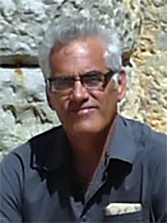Seminars
Dr. George A. Gazonas
DEVCOM Army Research Laboratory
Longitudinal Impact into Micropolar Media

ABSTRACT: We revisit the problem of wave propagation in micropolar (granular) media and present new one-dimensional (1-D) impact solutions for the direct impact Hopkinson pressure bar test configuration in which an elastic flyer impacts a micropolar target (specimen) backed by an elastic transmission bar. Herein, a 1-D micropolar body is kinematically described with two displacement fields: one field associated with longitudinal displacement and one associated with rotation. The rotation is in the same direction as longitudinal displacement, leading to a non-centrosymmetric 1-D micropolar medium. Two second-order partial differential equations result from the application of the balance of linear and angular momentum, yielding a mixed initial-boundary value problem consisting of initial conditions, and boundary conditions at the interface between the non-polar flyer, micropolar target and non-polar transmission bar. The impact generates multiple reflected fast and slow shock waves in the target. The Laplace transform and a novel impact boundary condition we derived are used to develop analytical solutions for the stress and particle velocity in the Laplace transform domain at any point of the pressure bar system. The final value theorem is used to show that the asymptotic stress and particle velocity is independent of target properties in micropolar media but depend only on the impedance of the striker and transmission bars; similar asymptotic impact results have been obtained for other classes of materials. Our findings aid in determining whether impact induced stress waves are mitigated in structures in which a micropolar solid is bonded between dissimilar materials.
BIOGRAPHY: Dr. Gazonas has been a Research Physicist at the U.S. Army Combat Capabilities Development Command Research Laboratory since 1989, and currently is the Deformation and Failure Mechanics Team lead in the Materials Response and Design Branch. He has over 40 years’ experience in the fields of computational mechanics, dynamic fracture, homogenization methods for fractured media, and shock and wave propagation in solids. Gazonas is on the editorial advisory board of the International Journal of Impact Engineering and prior to this served as a volunteer editor for the Journal of Geophysical Research: Solid Earth & Planets; he is a member of the American Geophysical Union, SES, and the United States Association for Computational Mechanics. Gazonas received his Ph.D. in Geophysics from Texas A&M University in 1985, and began his career in the oil & gas industry as Chief Geophysicist for Hunter Geophysics, Santa Clara, California; at Hunter, he co-pioneered, with M.D. Wood, the use of a tiltmeter data acquisition & telemetry system which was coupled to a nonlinear inversion program he developed, that enabled real-time subsurface mapping of hydraulically induced fractures in secondary oil & gas recovery operations throughout the U.S. and Canada.